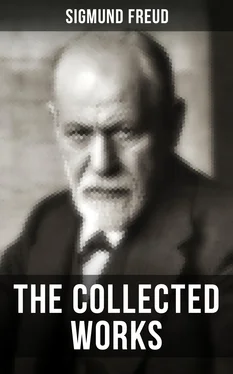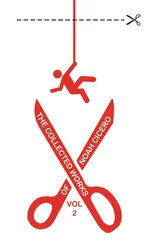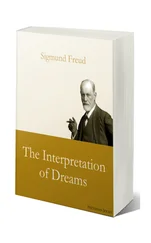In the same manner the genital symbolism is just as little peculiar to the dream alone. Every one of you has perhaps at some time or other been so unkind as to call some woman an “ old casket ” without perhaps being aware that he was using a genital symbol. In the New Testament one may read “Woman is a weak vessel .” The Holy Scriptures of the Jews, so nearly poetic in their style, are filled with sex-symbolic expressions which have not always been correctly understood, and the true construction of which, in the Song of Songs , for example, has led to many misunderstandings. In the later Hebraic literature the representation of woman as a house, the door taking the place of the sex opening, is very widespread. The man complains, for instance, when he discovers a lack of virginity, that he has found the door open . The symbol of the table for woman is also known to this literature. The woman says of her husband, “I set the table for him, but he upset it .” Lame children are supposed to result from the fact that the man has overturned the table . I take these examples from a work by L. Levy of Brünn, The Sexual Symbolism of the Bible and the Talmud .
That ships, too, represent women in dreams is a belief derived from the etymologists, who maintain “ship” was originally the name of an earthen vessel and is the same word as Schaff (to create). The Greek myth of Periander of Corinth and his wife Melissa is proof that the stove or oven is a woman, and a womb. When, according to Herodotus, the tyrant entreated the shade of his beloved wife, whom, however, he had murdered in a fit of jealousy, for some sign of its identity, the deceased identified herself by the reminder that he, Periander , had thrust his bread into a cold oven , as a disguise for an occurrence that could have been known to no other person. In the Anthropophyteia published by F. S. Krauss, an indispensable source book for everything that has to do with the sex life of nations, we read that in a certain German region it is commonly said of a woman who has just been delivered of a child, “ Her oven has caved in .” The making of a fire and everything connected therewith is filled through and through with sex symbolism. The flame is always the male genital, the fireplace, the hearth, is the womb of the woman.
If you have often wondered why it is that landscapes are so often used to represent the female genitals in the dream, then let the mythologist teach you the role Mother Earth has played in the symbolisms and cults of ancient times. You may be tempted to say that a room represents a woman in the dream because of the German colloquialism which uses the term Frauenzimmer instead of Frau , in other words, it substitutes for the human person the idea of that room that is set aside for her exclusive use. In like manner we speak of the Sublime Porte , and mean the Sultan and his government; furthermore, the name of the ancient Egyptian ruler, Pharaoh, means nothing other than “great court room.” (In the ancient Orient the court yards between the double gates of the town were the gathering places of the people, in the same manner as the market place was in the classical world.) What I mean is, this derivation is far too superficial. It seems more probable to me that the room, as the space surrounding man, came to be the symbol of woman. We have seen that the house is used in such a representation; from mythology and poetry we may take the city , fortress , palace , citadel , as further symbols of woman. The question may easily be decided by the dreams of those persons who do not speak German and do not understand it. In the last few years my patients have been predominantly foreign-language speaking, and I think I can recall that in their dreams as well the room represents woman, even where they had no analogous usages in their languages. There are still other signs which show that the symbolization is not limited by the bounds of language, a fact that even the old dream investigator, Schubert (1862) maintained. Since none of my dreamers were totally ignorant of German I must leave this differentiation to those psychoanalysts who can gather examples in other lands where the people speak but one language.
Among the symbol-representations of the male genital there is scarcely one that does not recur in jokes or in vulgar or poetical usage, especially among the old classical poets. Not alone do those symbols commonly met with in dreams appeal here, but also new ones, e.g., the working materials of various performances, foremost of which is the incantation. Furthermore, we approach in the symbolic representation of the male a very extended and much discussed province, which we shall avoid for economic reasons. I should like to make a few remarks, however, about one of the unclassified symbols — the figure 3. Whether or not this figure derives its holiness from its symbolic meaning may remain undecided. But it appears certain that many objects which occur in nature as three-part things derive their use as coats-of-arms and emblems from such symbolic meaning, e.g., the clover, likewise the three-part French lily, (fleur-delys), and the extraordinary coats-of-arms of two such widely separated islands as Sicily and the Isle of Man, where the Triskeles (three partly bended knees, emerging from a central point) are merely said to be the portrayal in a different form of the male genitals. Copies of the male member were used in antiquity as the most powerful charms ( Apotropaea ) against evil influences, and this is connected with the fact that the lucky amulets of our own time may one and all be recognized as genital or sex-symbols. Let us study such a collection, worn in the form of little silver pendants: the four-leaf clover, a pig, a mushroom, a horse-shoe, a ladder, a chimney-sweep. The four-leaf clover, it seems, has usurped the place of the three-leaf clover, which is really more suitable as a symbol; the pig is an ancient symbol of fertility; the mushroom is an unquestionable penis symbol — there are mushrooms that derive their systematic names from their unmistakable similarity to the male member (Phallus impudicus); the horseshoe recalls the contour of the female genital opening; and the chimney sweep who carries a ladder belongs in this company because he carries on that trade with which the sex-intercourse is vulgarly compared ( cf. the Anthropophyteia ). We have already become acquainted with his ladder as a sex symbol in the dream; the German usage is helpful here, it shows us how the verb “to mount” 30 is made use of in an exquisite sexual sense. We use the expressions “ to run after women ,” which literally translated would be “ to climb after women ,” and “ an old climber .” 31 In French, where “ step ” is “ la marche ” we find that the analogous expression for a man about town is “ un vieux marcheur .” It is apparently not unknown in this connection that the sexual intercourse of many of the larger animals requires a mounting, a climbing upon the female.
The tearing off of a branch as the symbolic representation of onanism is not alone in keeping with the vulgar representation of the fact of onanism, but has far-reaching mythological parallels. Especially noteworthy, however, is the representation of onanism, or rather the punishment therefor, castration, by the falling out or pulling out of teeth, because there is a parallel in folk-lore which is probably known to the fewest dreamers. It does not seem at all questionable to me that the practice of circumcision common among so many peoples is an equivalent and a substitute for castration. And now we are informed that in Australia certain primitive tribes practice circumcision as a rite of puberty (the ceremony in honor of the boy’s coming of age), while others, living quite near, have substituted for this act the striking out of a tooth.
Читать дальше












